Persuasive Technologies for Sustainable Mobility: State of the Art and Emerging Trends
Abstract
1. Introduction
2. Methodology
3. Results
3.1. Persuasive Technology in Mobility by Year
3.2. Employed Persuasive Strategies
3.3. Persuasive Systems for Sustainable Mobility
3.4. Evaluation of Persuasive Technologies for Sustainable Mobility
3.4.1. Evaluation Methodologies
3.4.2. Type of Outcome Evaluated
3.5. Results of Persuasive Technologies Evaluations and Impact on Travel Behaviour
4. Discussion and Research Challenges
4.1. General Observations
4.2. Effectiveness of Persuasive Technology for Sustainable Mobility
4.3. The Relationship between Persuasive Technology and Behavioural Change Theories
4.4. Limitations of Existing Technologies and Future Opportunities
- Personalization is seen as an important possibility to improve the impact of the systems and to increase acceptability and real-life usage. In the context of mobile persuasion, aspects to consider for personalization purposes are especially route suggestions and alternatives.
- Contextualization of interventions, which refers to providing the right information at the right time and location, is considered important in order to deliver more relevant interventions.
- Good timing of interventions is important both for increasing the impact of the system and the acceptance by the users.
4.4.1. Personalization
4.4.2. Context Awareness
4.4.3. Proactivity
5. Conclusions
Author Contributions
Funding
Acknowledgments
Conflicts of Interest
References
- Kahn Ribeiro, S.; Kobayashi, S.; Beuthe, M.; Gasca, J.; Greene, D.; Lee, D.S.; Muromachi, Y.; Newton, P.J.; Plotkin, S.; Sperling, D.; et al. Transport and its infrastructure. In Climate Change 2007: Mitigation. Contribution of Working Group III to the Fourth Assessment Report of the Intergovernmental Panel on Climate Change; Metz, B., Davidson, O.R., Bosch, P.R., Dave, R., Meyer, L.A., Eds.; Cambridge University Press: Cambridge, UK; New York, NY, USA, 2007. [Google Scholar]
- Pucher, J.; Dijkstra, L. Promoting safe walking and cycling to improve public health: Les-sons from the Netherlands and Germany. Am. J. Public Health 2003, 93, 1509–1516. [Google Scholar] [CrossRef] [PubMed]
- Holleis, P.; Luther, M.; Broll, G.; Cao, H.; Koolwaaij, J.; Peddemors, A.; Ebben, P.; Wibbels, M.; Jacobs, K.; Raaphorst, S. TRIPZOOM: A system to motivate sustainable urban mobility. In Proceedings of the 1st International Conference on Smart Systems, Devices and Technologies, Stuttgart, Germany, 27 May–1 June 2012. [Google Scholar]
- Fogg, B.J. Persuasive Technology: Using Computers to Change What We Think and Do; Morgan Kaufmann: San Francisco, CA, USA, 2003. [Google Scholar]
- Kitchenham, B.A.; Charters, S. Procedures for Performing Systematic Literature Reviews in Software Engineering; EBSE Technical Report; Software Engineering Group, Keele University: Keele, UK; Department of Computer Science, University of Durham: Durham, UK, 2007. [Google Scholar]
- Reitberger, W.; Ploderer, B.; Obermair, C.; Tscheligi, M. The PerCues Framework and Its Application for Sustainable Mobility. In Proceedings of the 2nd International Conference on Persuasive Technology, Palo Alto, CA, USA, 26–27 April 2007; pp. 92–95. [Google Scholar]
- Froehlich, J.; Dillahunt, T.; Klasnja, P.; Mankoff, J.; Consolvo, S.; Harrison, B.; Landay, J.A. UbiGreen: Investigating a Mobile Tool for Tracking and Supporting Green Transportation Habits. In SIGCHI Conference on Human Factors in Computing Systems; ACM: New York, NY, USA, 2009; pp. 1043–1052. [Google Scholar]
- Jariyasunant, J.; Abou-Zeid, M.; Carrel, A.; Ekambaram, V.; Gaker, D.; Sengupta, R.; Walker, J. Quantified Traveler: Travel Feedback Meets the Cloud to Change Behavior. J. Intell. Transp. Syst. 2013, 19, 109–124. [Google Scholar] [CrossRef]
- Jylhä, A.; Nurmi, P.; Sirén, M.; Hemminki, S.; Jacucci, G. MatkaHupi: A Persuasive Mobile Application for Sustainable Mobility. In Proceedings of the 2013 ACM Conference on Pervasive and Ubiquitous Computing Adjunct Publication, Zurich, Switzerland, 8–12 September 2013. [Google Scholar]
- Meloni, I.; Sanjust, B.; Delogu, G.; Sottile, E. Development of a technological platform for implementing VTBC programs. Transp. Res. Procedia 2014, 3, 129–138. [Google Scholar] [CrossRef]
- Bothos, E.; Prost, S.; Schrammel, J.; Röderer, K.; Mentzas, G. Watch your Emissions: Persuasive Strategies and Choice Architecture for Sustainable Decisions in Urban Mobility. PsychNol. J. 2014, 12, 107–126. [Google Scholar]
- Baird, T.; Zhao, J. ‘Nudging’ Active Travel: A Framework for Behavioral Interventions Using Mobile Technology. In Proceedings of the Transportation Research Board 93rd Annual Meeting, Washington, DC, USA, 12–16 January 2014. [Google Scholar]
- Gabrielli, S.; Maimone, R. Digital Interventions for Sustainable Urban Mobility: A Pilot Study. In Proceedings of the 2013 ACM Conference on Pervasive and Ubiquitous Computing Adjunct Publication, Zurich, Switzerland, 8–12 September 2013. [Google Scholar]
- Kazhamiakin, R.; Marconi, A.; Perillo, M.; Pistore, M.; Valetto, G.; Piras, L.; Perri, N. Using Gamification to Incentivize Sustainable Urban Mobility. In Proceedings of the IEEE International Smart Cities Conference (ISC2), Guadalajara, Mexico, 25–28 October 2015; pp. 1–6. [Google Scholar]
- Oinas-Kukkonen, H.; Harjumaa, M. A Systematic Framework for Designing and Evaluating Persuasive Systems. In Proceedings of the 3rd International Conference on Persuasive technology, Oulu, Finland, 4–6 June 2008; pp. 164–176. [Google Scholar]
- Takayama, C.; Lehdonvirta, V.; Shiraishi, M.; Washio, Y.; Kimura, H.; Nakajima, T. Ecoisland: A system for persuading users to reduce CO2 emissions. In Software Technologies for Future Dependable Distributed Systems; IEEE: Tokyo, Japan, 2009; pp. 59–63. [Google Scholar]
- Bliznyuk, A. Green Daily Guide. Easier environmentally friendly transportation with the help of mobile technologies. In Proceedings of the 2011 IEEE International Conference on Collaboration Technologies and Systems (CTS), Philadelphia, PA, USA, 23–27 May 2011. [Google Scholar]
- Shankari, K.; Park, J.; Gadgil, T.; Katz, R.H.; Culler, D.E. Information Display for Societal Problems: Data, Game, or Choice? Technical Report No. UCB/EECS-2015-7; University of California at Berkeley: Berkeley, CA, USA, 2015. [Google Scholar]
- Ebermann, C.; Brauer, B. The Role of Goal Frames Regarding the Impact of Gamified Persuasive Systems on Sustainable Mobility Behavior. In Proceedings of the 24th European Conference on Information Systems, İstanbul, Turkey, 12–15 June 2016. [Google Scholar]
- Wunsch, M.; Millonig, A.; Seer, S.; Schechtner, K.; Stibe, A.; Chin, R.C. Challenged to bike: Assessing the potential impact of gamified cycling initiatives. In Proceedings of the Transportation Research Board 95th Annual Meeting, Washington, DC, USA, 10–14 January 2016. [Google Scholar]
- Semanjski, I.; Lopez Aguirre, A.J.; De Mol, J.; Gautama, S. Policy 2.0 Platform for mobile sensing and incentivized targeted shifts in mobility behavior. Sensors 2016, 16, 1035. [Google Scholar] [CrossRef] [PubMed]
- Khoshkangini, R.; Giuseppe, V.; Marconi, A. Generating Personalized Challenges to Enhance the Persuasive Power of Gamification. In Proceedings of the Second International Workshop on Personalization in Persuasive Technology Co-Located with the 12th International Conference on Persuasive Technology, Amsterdam, The Netherlands, 3–6 April 2017. [Google Scholar]
- Schrammel, J.; Prost, S.; Mattheiss, E.; Bothos, E.; Tscheligi, M. Using Individual and Collaborative Challenges in Behavior Change Support Systems: Findings from a Two-Month Field Trial of a Trip Planner Application. In Proceedings of the International Conference on Persuasive Technology, Chicago, IL, USA, 4–5 June 2015; Springer: Cham, Switzerland, 2015; pp. 160–171. [Google Scholar]
- Petri, M.; Pratelli, A.; Farina, A.; Buffi, A.; Franchina, V.; Nepa, P.; Christian, I. The SaveMyBike Project: ITS Technologies and Rewarding Policies to Improve Sustainable Mobility in Cities. In Proceedings of the Transportation Research Arena TRA, Vienna, Austria, 16–19 April 2018; pp. 1–10. [Google Scholar]
- Cheng, Y.-M.; Chao-Lung, L. Persuasive and engaging design of a Smartphone App for cycle commuting. mUX J. Mobile User Exp. 2015, 4, 1–5. [Google Scholar] [CrossRef]
- Park, H.; Sanguinetti, A.; Cortes, G.C. EcoTrips: Leveraging Co-benefits and Metaphorical Metrics in a Mobile App to Promote Walking and Biking for Short Trips. In Proceedings of the International Conference of Design, User Experience, and Usability, Vancouver, BC, Canada, 9–14 July 2017; Springer: Cham, Switzerland, 2017; pp. 60–76. [Google Scholar]
- Myrovali, G.; Tsaples, G.; Morfoulaki, M.; Aifadopoulou, G.; Papathanasiou, J. An Interactive Learning Environment Based on System Dynamics Methodology for Sustainable Mobility Challenges Communication & Citizens’ Engagement. In Proceedings of the International Conference on Decision Support System Technology, Crete, Greece, 22–25 May 2018; Springer: Cham, Switzerland, 2018; pp. 88–99. [Google Scholar]
- Anagnostopoulou, E.; Bothos, E.; Magoutas, B.; Schrammel, J.; Mentzas, G. Persuasive Interventions for Sustainable Travel Choices Leveraging Users’ Personality and Mobility Type. In Proceedings of the International Conference on Persuasive Technology, Waterloo, ON, Canada, 16–19 April 2018; Springer: Cham, Switzerland, 2018; pp. 229–241. [Google Scholar]
- Brazil, W.; Caulfield, B.; Bothos, E. An Examination of the Role of Emissions Information in Transport Behaviour: The Results of a Smart Phone Trial in Dublin, Ireland. In Proceedings of the 96th Annual Meeting of the Transportation Research Board, Washington, DC, USA, 8–12 January 2017. [Google Scholar]
- Harries, T.; Eslambolchilar, P.; Stride, C.; Rettie, R.; Walton, S. Walking in the wild–Using an always-on smartphone application to increase physical activity. In Proceedings of the IFIP Conference on Human-Computer Interaction, Cape Town, South Africa, 2–6 September 2013; Springer: Berlin/Heidelberg, Germany, 2013. [Google Scholar]
- Bamberg, S. Applying the stage model of self-regulated behavioral change in a car use reduction intervention. J. Environ. Psychol. 2013, 33, 68–75. [Google Scholar] [CrossRef]
- Mun, M.; Reddy, S.; Shilton, K.; Yau, N.; Burke, J.; Estrin, D.; Boda, P. PEIR, the personal environmental impact report, as a platform for participatory sensing systems research. In Proceedings of the 7th International Conference on Mobile Systems, Applications, and Services, Krakow, Poland, 22 June 2009; ACM: Wroclaw, Poland, 2009. [Google Scholar]
- Gabrielli, S.; Maimone, R.; Forbes, P.; Masthoff, J.; Wells, S.; Primerano, L.; Pompa, M. Designing motivational features for sustainable urban mobility. In CHI’13 Extended Abstracts on Human Factors in Computing Systems; ACM: Paris, France, 2013. [Google Scholar]
- Meurer, J.; Lawo, D.; Janßen, L.; Wulf, V. Designing mobility eco-feedback for elderly users. In Proceedings of the 2016 CHI Conference Extended Abstracts on Human Factors in Computing Systems, San Jose, CA, USA, 7–12 May 2016; ACM: New York, NY, USA, 2016. [Google Scholar]
- Magliocchetti, D.; Gielow, M.; De Vigili, F.; Conti, G.; De Amicis, R. A personal mobility assistant based on ambient intelligence to promote sustainable travel choices. Procedia Comput. Sci. 2011, 5, 892–899. [Google Scholar] [CrossRef]
- Sochor, J.L.; Strömberg, H.; Karlsson, M. Travelers’ Motives for Adopting a New, Innovative Travel Service: Insights from the UbiGo Field Operational Test in Gothenburg, Sweden. In Proceedings of the 21st World Congress on Intelligent Transport Systems, Detroit, MI, USA, 7–11 September 2014. [Google Scholar]
- Pangbourne, K.; Masthoff, J. Personalised Messaging for Voluntary Travel Behaviour Change: Interactions between Segmentation and Modal Messaging; Universities Transport Studies Group: Bristol, UK, 2016. [Google Scholar]
- Wells, S. SUPERHUB: Towards Argumentatively Rich Persuasive Communication in Large-Scale, Applied Behaviour Change Systems; Extended abstract for Computational Models of Argument (COMMA) Demo Track; IOS Press: Scottish Highlands, UK, 2014. [Google Scholar]
- Wells, S.; Pangbourne, K. Using Argumentation within Sustainable Transport Communication. In Argumentation and Reasoned Action, Proceedings of the 1st European Conference on Argumentation; College Publications: Lisbon, Portugal, 2015; Volume 1. [Google Scholar]
- Castell, N.; Liu, H.; Kobernus, M.; Berre, A.J.; Noll, J.; Cagatay, E.; Gangdal, R. Mobile technologies and personalized environmental information for supporting sustainable mobility in Oslo: The Citi-Sense-MOB approach. In Proceedings of the 28th International Conference on Informatics for Environmental Protection, Oldenburg, Germany, 10–12 September 2014. [Google Scholar]
- Wu, S.; Bai, Q.; Sengvong, S. Greencommute: An influence-aware persuasive recommendation approach for public-friendly commute options. J. Syst. Sci. Syst. Eng. 2018, 27, 250–264. [Google Scholar] [CrossRef]
- Kelpin, R.; Flemming, G.; Heinrichs, M. Streetlife Field Trials—Applied Gamification Approaches as a Key to more Sustainable Mobility Behaviour. In Proceedings of the 44th European Transport Conference, Barcelona, Spain, 5–7 October 2016. [Google Scholar]
- Huang, B.; Thomas, T.; Groenewolt, B.; Fioreze, T.; van Berkum, E. The Effect of Incentives to Promote Cycling: A Mobility Living Lab. In Proceedings of the Transportation Research Board 97th Annual Meeting, Washington, DC, USA, 7–11 January 2018. [Google Scholar]
- Waygood, E.; Owen, D.; Avineri, E. Analytical or Emotional? Which stimulates greater sustainable travel intention. In Proceedings of the 92nd Annual Meeting of the Transportation Research Board, Washington, DC, USA, 13–17 January 2013. [Google Scholar]
- Waygood, O.; Avineri, E. The effect of loss framing on the perceived difference of CO2 amounts: Implications for advanced travel information systems (ATIS). In Proceedings of the 43rd Universities Transport Study Group Conference, Milton Keynes, UK, 5–7 January 2011. [Google Scholar]
- Avineri, E. Applying behavioural economics in the design of travel information systems. In Proceedings of the 43rd Universities Transport Study Group Conference, Milton Keynes, UK, 5–7 January 2011. [Google Scholar]
- Avineri, E. User interpretation of travel information and implications for system design. In Proceedings of the 6th ACM Workshop on Next Generation Mobile Computing for Dynamic Personalised Travel Planning, Ambleside, UK, 25–29 June 2012. [Google Scholar]
- Steg, L. Car Use: Lust and Must. Instrumental, Symbolic and Affective Motives for Car Use. Transp. Res. Part A Policy Pract. 2005, 39, 147–162. [Google Scholar] [CrossRef]
- Fielding, K.S.; Head, B.W. Determinants of Young Australians Environmental Actions: The Role of Responsibility Attributions, Locus of Control, Knowledge and Attitudes. Environ. Educ. Res. 2011, 18, 171–186. [Google Scholar] [CrossRef]
- Worsley, A.; Skrzypiec, G. Environmental Attitudes of Senior Secondary School Students in South Australia. Glob. Environ. Chang. 1998, 8, 209–225. [Google Scholar] [CrossRef]
- Schahn, J.; Damian, M.; Schurig, U.; Füchsle, C. Konstruktion und Evaluation der dritten Version des Skalensystems zur Erfassung des Umweltbewusstseins (SEU-3). Diagnostika 2000, 46, 84–96. [Google Scholar] [CrossRef]
- Prochaska, J.O.; Velicer, W.F. The transtheoretical model of health behavior change. Am. J. Health Promot. 1997, 12, 38–48. [Google Scholar] [CrossRef] [PubMed]
- Ajzen, I. Theory of planned behavior. Organ. Behav. Hum. Decis. Process. 2011, 50, 179–211. [Google Scholar] [CrossRef]
- Heckhausen, H.; Gollwitzer, P.M. Thought contents and cognitive functioning in motivational versus volitional states of mind. Motiv. Emotion 1987, 11, 101–120. [Google Scholar] [CrossRef]
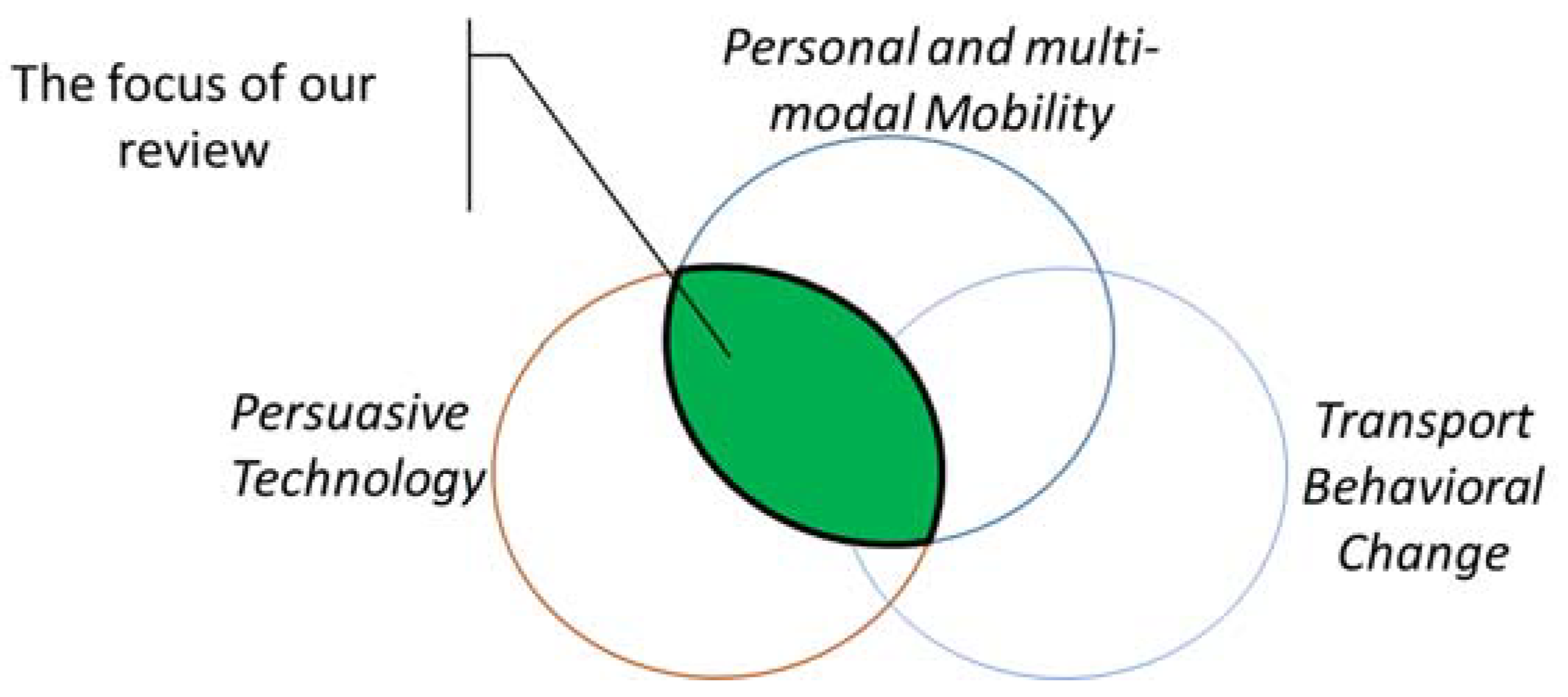
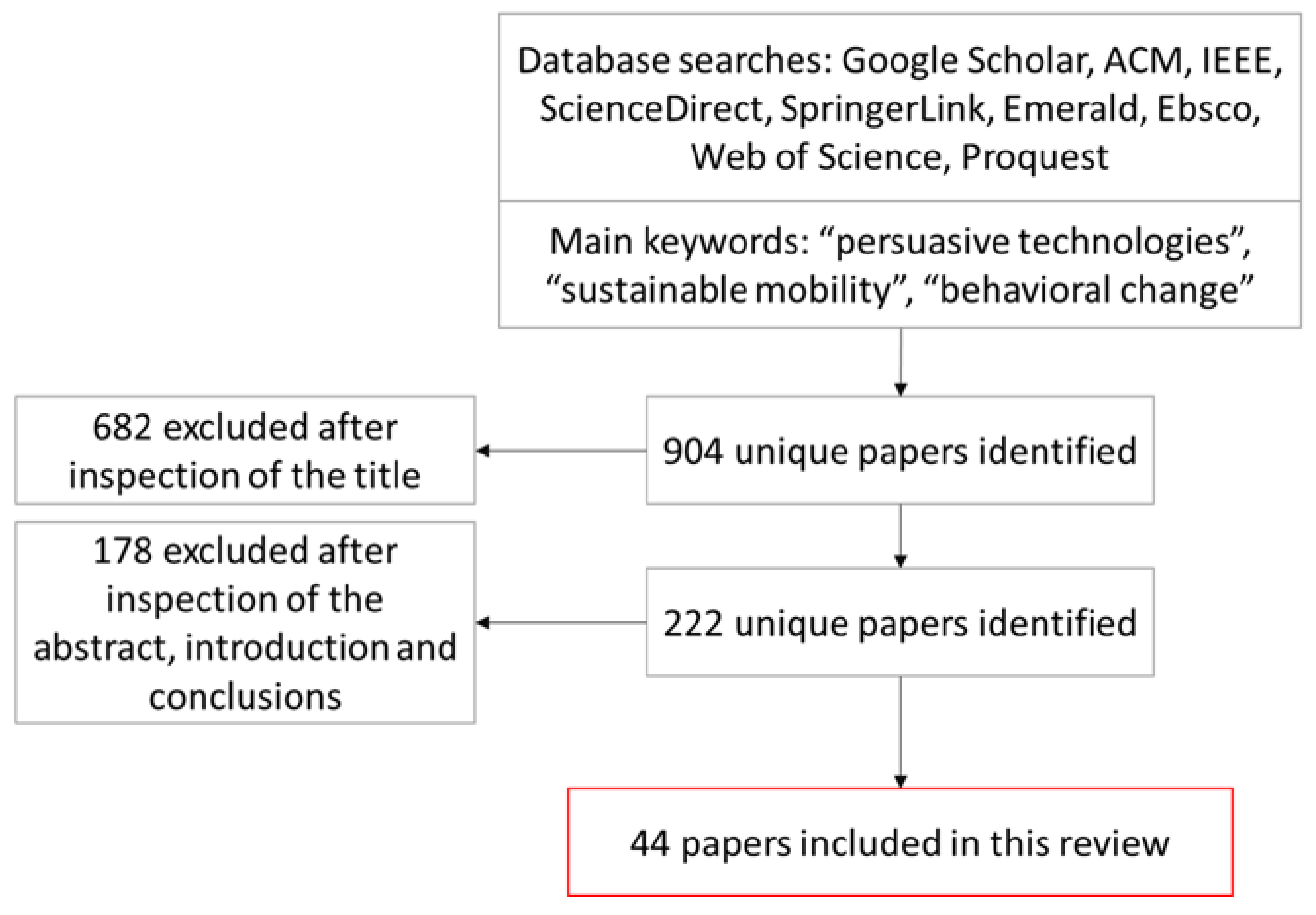
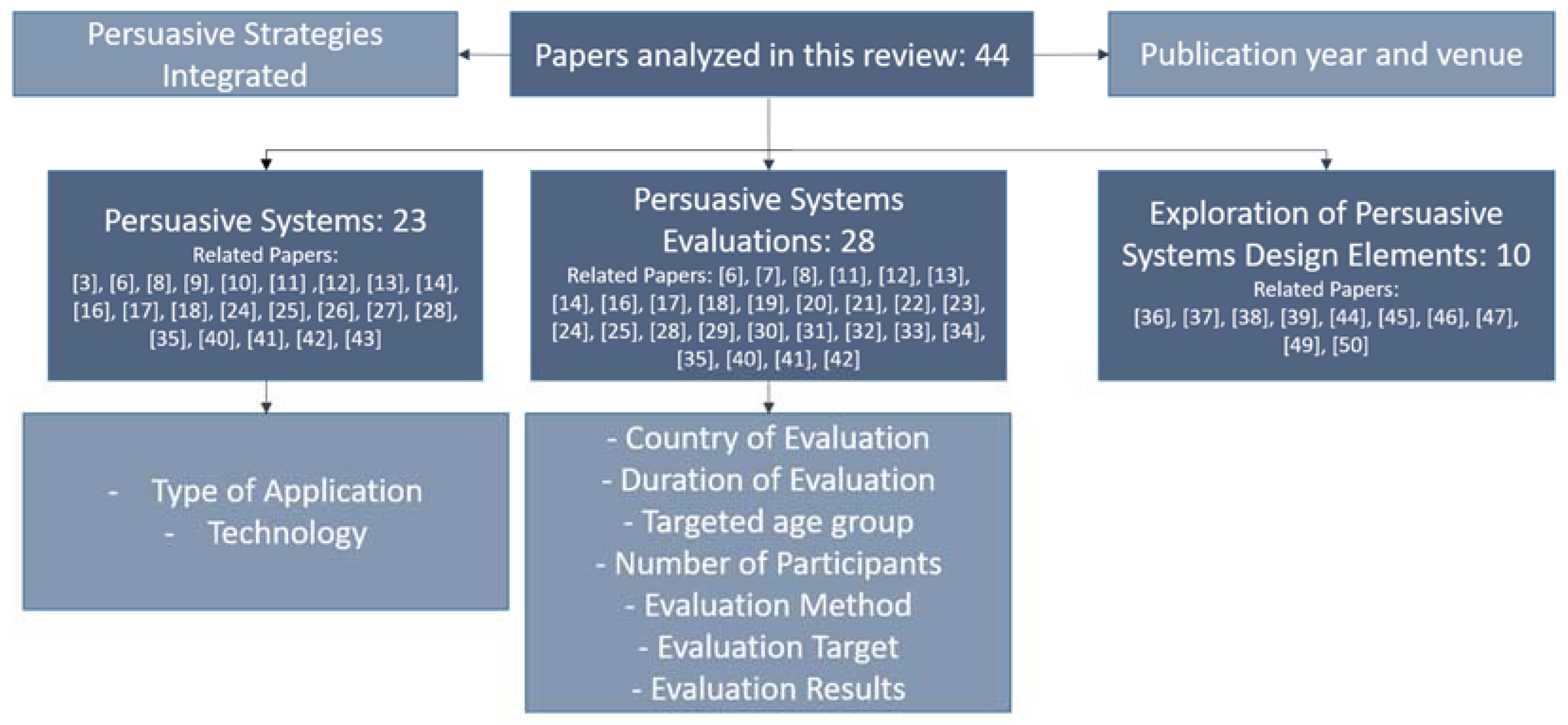
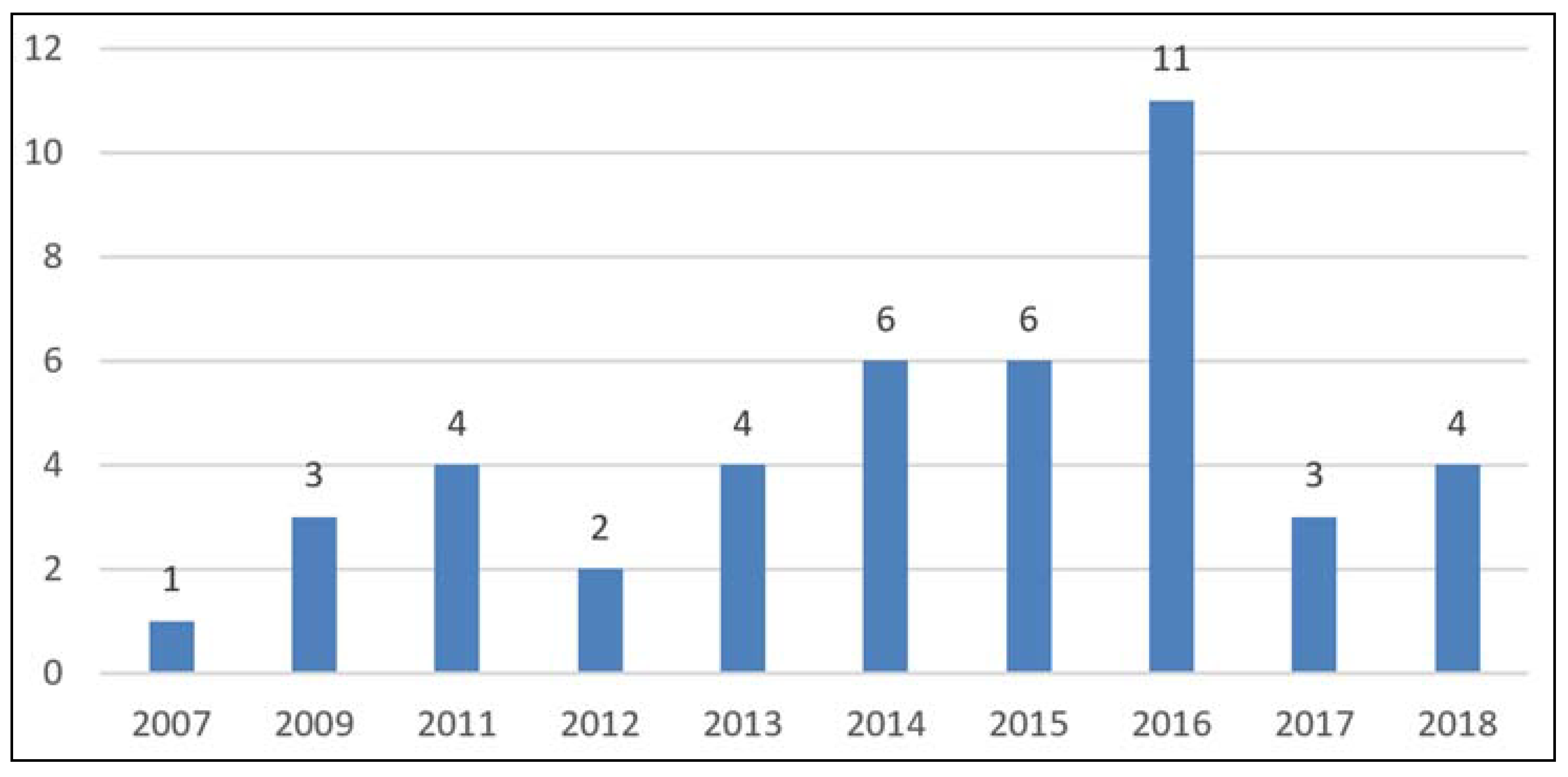
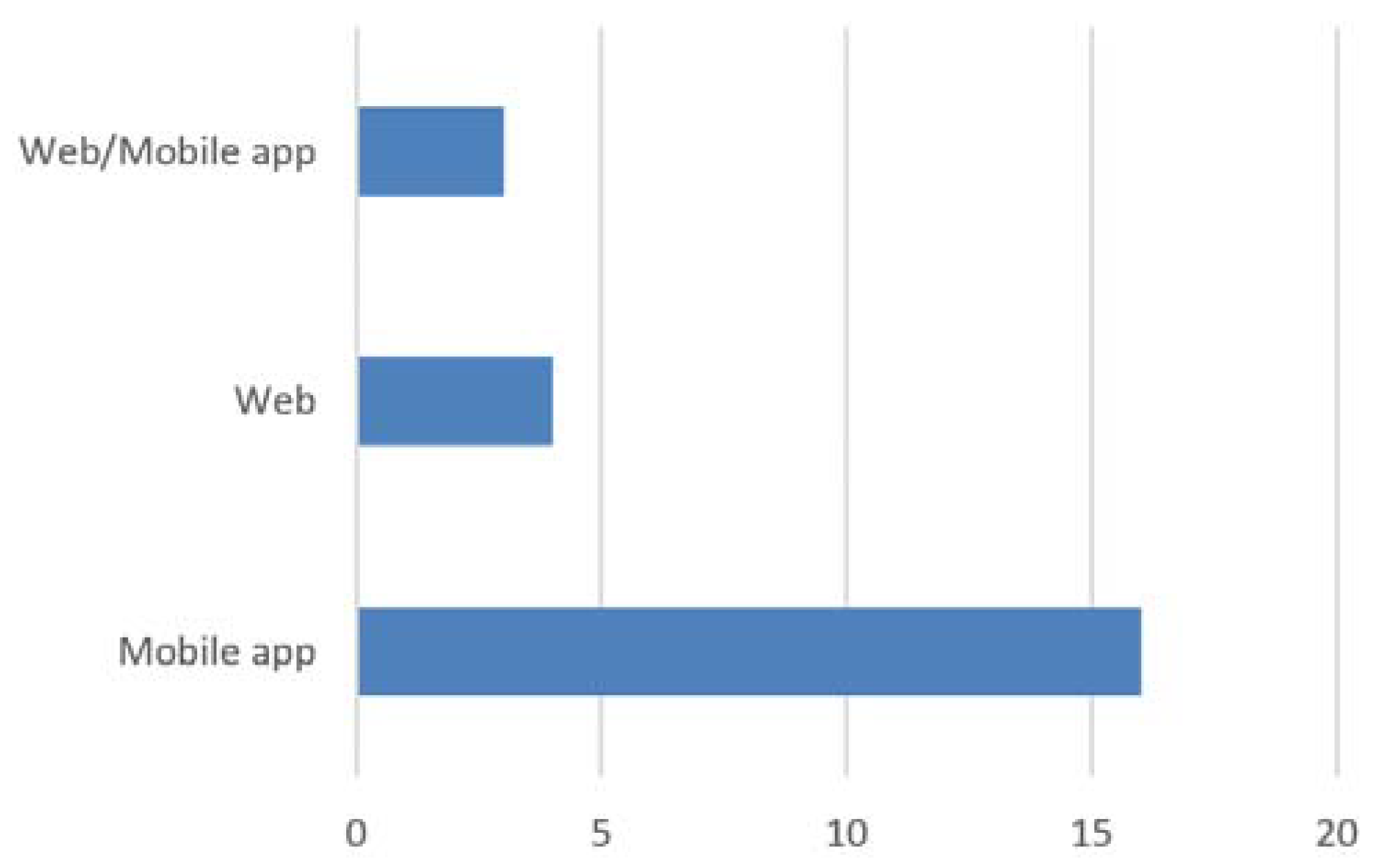
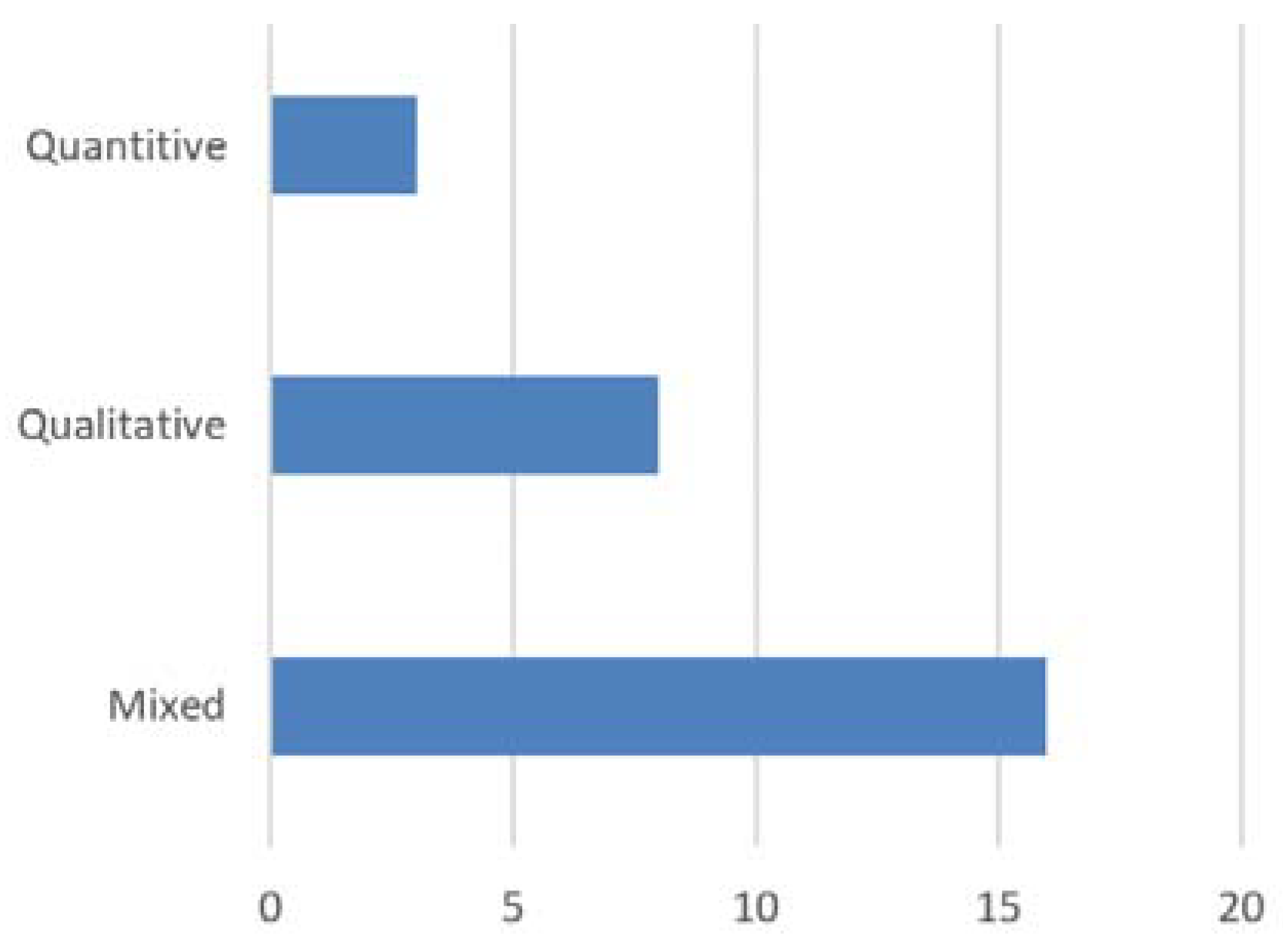
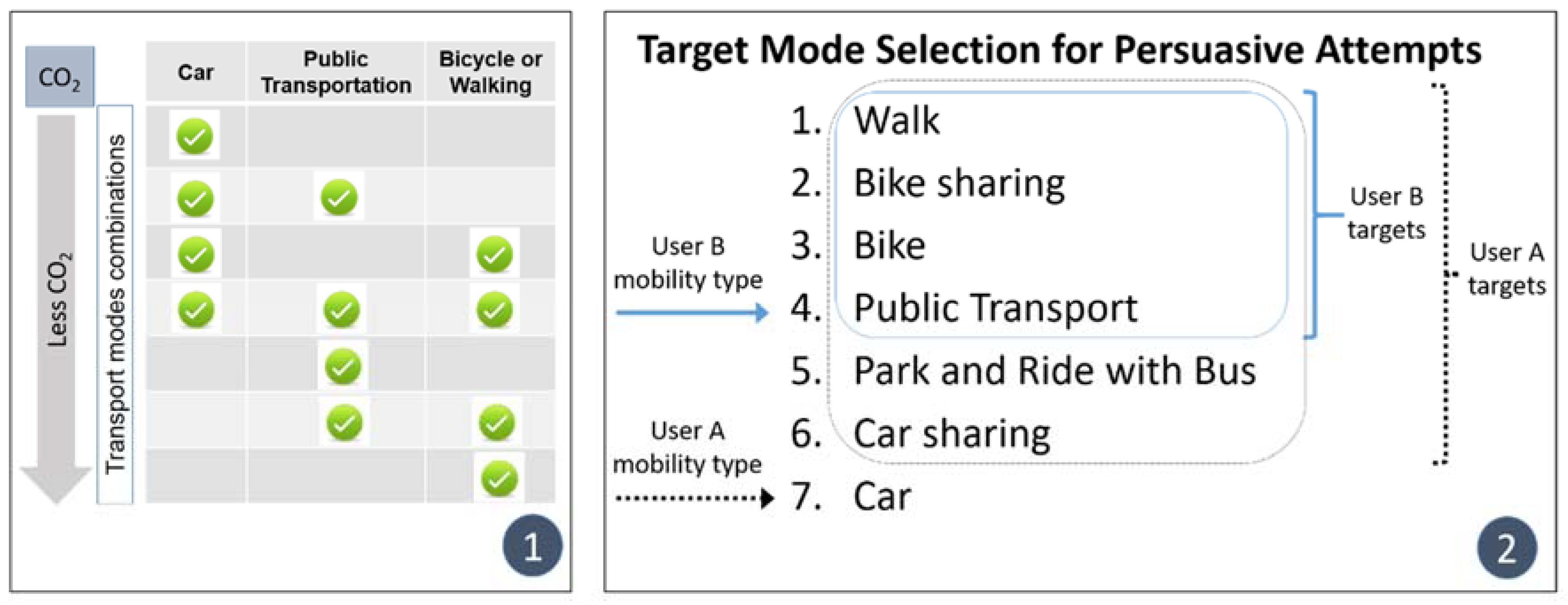
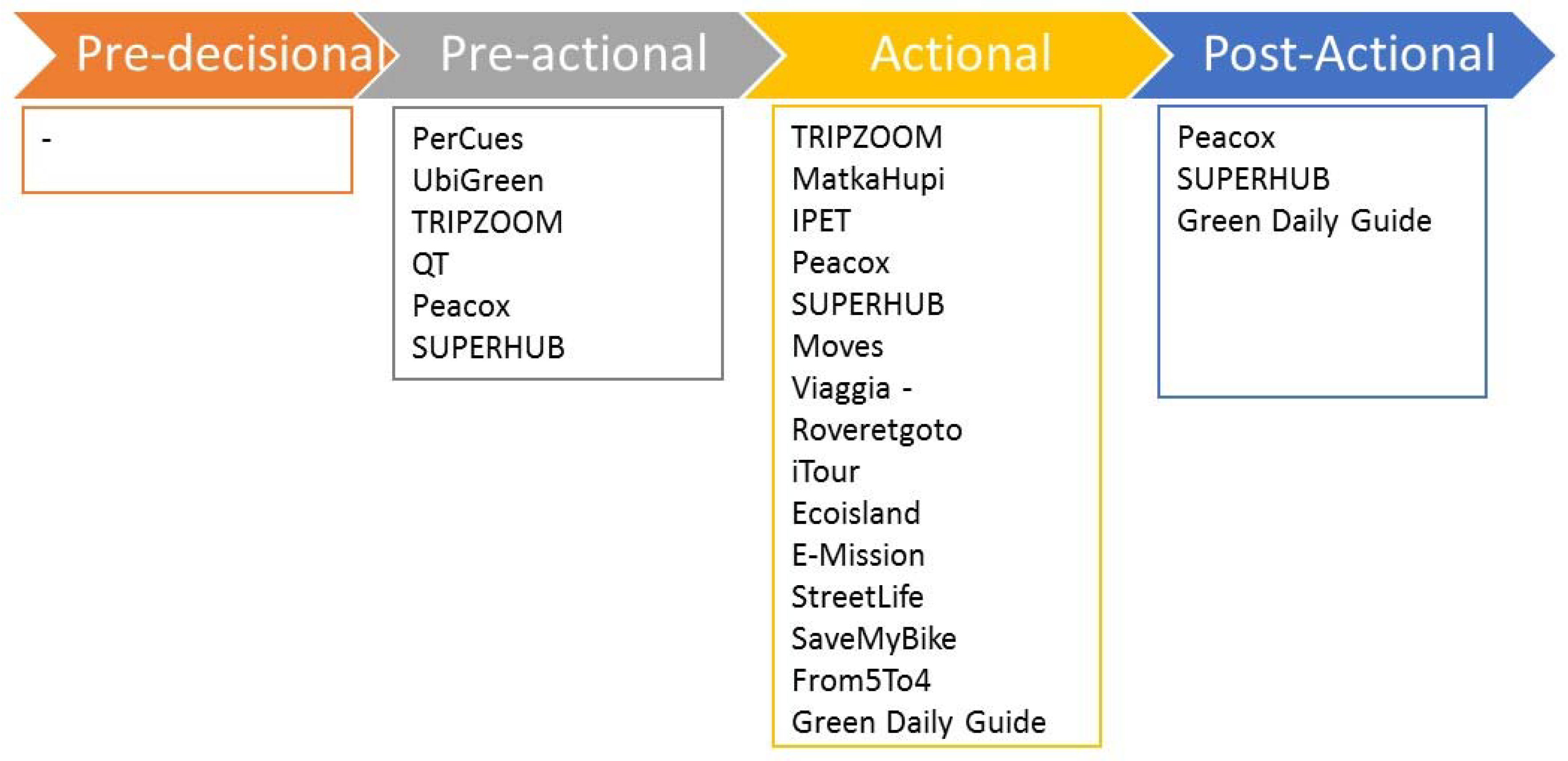
| # | Topic of Analysed Papers | Analysis Dimensions Considered | Identified Classifications |
|---|---|---|---|
| 1 | Design, System, Evaluation | Descriptive Information | Year and country |
| 2 | Persuasive Strategies Integrated | Persuasive strategies used in the design of the system (see Table 2 for an overview of the persuasive strategies which are used in the reviewed papers). | |
| 3 | System | Type of Application | Route planning, game, feedback. |
| 4 | Technology | Web app, mobile app, both, design only. | |
| 5 | Evaluation | Country of Evaluation | Country where the study/pilot was conducted. |
| 6 | Duration of Evaluation | Hours, Days, Weeks, Months, Years. | |
| 7 | Number of Participants | Number of participants involved in the evaluation. | |
| 8 | |||
| 9 | Evaluation Method | Quantitative, Qualitative, Mixed. | |
| 10 | Evaluation Target | Behaviour, Attitude, System/approach. | |
| 11 | Evaluation Results | Successful, partially successful, not successful. |
| Persuasive Strategy | Description (Adopted from [15] | Frequency of Identified Studies |
|---|---|---|
| Challenges & Goal Setting | Offering challenges and setting goals that incentivise the user to show an intended behaviour in a self-competitive context through a comparison of the present and a desirable future situation. Related Papers: [3,9,11,13,16,17,18,19,20,21,22,23] | 29% |
| Self-monitoring and Feedback | Applying computing technology to eliminate the tedium of tracking performance or status helps people to achieve predetermined goals or outcomes. Related Papers: [6,7,8,9,10,11,12,13,20,24,25,26,27,28,29,30,31,32,33,34] | 45% |
| Tailoring | Information provided by computing technology will be more persuasive if it is tailored to the individual’s needs, interests, personality, usage context, or other factors relevant to the individual. Related Papers: [13,14,16,21,23,32,35,36,37,38,39] | 27% |
| Social comparison | System users will have a greater motivation to perform the target behaviour if they can compare their performance with the performance of others. Related Papers: [3,8,10,11,12,13,16,20,21,25,28,30,32,35,40,41] | 38% |
| Gamification & Rewards | To (virtually) reward target behaviours influences people to perform the target behaviour more frequently and effectively. Related Papers: [7,8,10,11,13,14,17,18,22,24,28,30,33,36,37,40,41,42,43,44] | 45% |
| Suggestion | Suggestion technologies are premised on the idea of intervening at the “Right Time”. People feel more motivated to perform some behaviours at certain times over others, so suggestion technologies are designed to identify these times and then remind users to perform the behaviours. Related Papers: [10,23,28,35] | 9% |
| Framing | Framing is a way of presenting a message in such a way that listeners see it one way as opposed to another. Related Papers: [45,46,47] | 4% |
| Reduction | Reduction technologies make a complex task simpler, usually by eliminating some of the steps of a sequence required to achieve a certain goal. Related Papers: [10,23] | 4% |
| Tunnelling | Tunneling technologies are designed to reduce “uncertainty”, by leading users through a predetermined sequence of actions or events, step by step, to encourage certain behaviors. Related Papers: [10,23] | 4% |
| Simulation | Systems that provide simulations can persuade by enabling users to observe immediately the link between cause and effect. Related Papers: [10,23] | 4% |
| Cooperation | Systems that motivate users to adopt a target attitude or behavior by leveraging human beings’ natural drive to cooperate. Related Papers: [25] | 2% |
| Ref. | Year | System | Type | Implemented Persuasive Strategies |
|---|---|---|---|---|
| [3] | 2003 | TRIPZOOM | Mobile | Self-monitoring, Challenges & Goal Setting, Social comparison |
| [6] | 2007 | PerCues | Mobile | Self-monitoring |
| [7] | 2009 | UbiGreen | Mobile | Self-monitoring |
| [16] | 2009 | Ecoisland | Mobile/web | Social comparison, Gamification, Challenges & Goal Setting |
| [9] | 2011 | iTour | Mobile | Tailoring, Suggestion, Social comparison |
| [17] | 2011 | Green Daily Guide | Mobile | Rewards, Gamification |
| [8] | 2013 | QT | Mobile/web | Self-monitoring, Social comparison |
| [35] | 2013 | MatkaHupi | Mobile | Self-monitoring, Challenges & Goal Setting |
| [13] | 2013 | SUPERHUB | Mobile | Self-monitoring, Challenges & Goal Setting, Social comparison, Tailoring, Gamification & Rewards |
| [10] | 2014 | IPET | Mobile | Self-monitoring, Tailoring |
| [11] | 2014 | Peacox | Mobile/web | Self-monitoring, Challenges & Goal Setting, Social comparison, Tailoring, Gamification & Rewards |
| [12] | 2014 | Moves | Mobile | Self-monitoring, Social comparison |
| [40] | 2014 | From5To4 | Web | Gamification, Comparison, Rewards |
| [14] | 2015 | Viaggia Roveretgoto | Mobile | Gamification & Rewards |
| [18] | 2015 | E-Mission | Mobile | Gamification, Challenges & Goal Setting, Self-monitoring |
| [42] | 2016 | StreetLife | Mobile | Gamification |
| [24] | 2016 | SaveMyBike | Web | Rewards, Self-monitoring |
| [25] | 2016 | BikeTogether | Mobile | Self-monitoring, comparison, cooperation |
| [26] | 2017 | EcoTrips | Mobile | Self-monitoring |
| [41] | 2018 | GreenCommute | Web | Rewards, Social comparison |
| [27] | 2018 | Motivate | Web | Self-monitoring, Gamification, Simulation, Rewards |
| [43] | 2018 | SMART | Mobile | Gamification, Rewards |
| [28] | 2018 | Optimum | Mobile | Self-monitoring, Comparison, Suggestion |
| Ref./Year | Focus of the Proposed Approach. | Users | Place | Duration | Evaluation Type |
|---|---|---|---|---|---|
| [6]/2007 | Persuade people to shift from using their cars to public transportation. | 54 | Austria | not available | Qualitative |
| [7]/2009 | To understand how participants react on visual feedback of CO2 emissions. | 14 | USA | 3 weeks | Qualitative |
| [8]/2013 | To explore whether travel feedback program can be replicated by a computational system. | 135 | USA | 3 weeks | Mixed |
| [9]/2013 | To explore users’ reaction to actionable mobility challenges presented through a journey planning app. | 12 | Finland | 4 weeks | Mixed |
| [11]/2014 | To explore the effects of persuasive strategies and choice architecture in journey planning systems for sustainable transportation. | 24 | Austria | 8 weeks | Mixed |
| [10]/2014 | To understand the impact of persuasive information and advices delivered through mobile devices on car usage reduction. | 15 | Italy | 2 weeks | Mixed |
| [13]/2013 | To explore the impact of a journey planner app integrating goal-setting, self-monitoring, rewards and sharing features on transport choices and habits. | 8 | Italy | 4 weeks | Mixed |
| [12]/2014 | To promote active modes such as bicycling and walking with the use of activity tracking smartphone applications. | 35 | USA | 3 weeks | Mixed |
| [14]/2015 | To explore the potential of gamification mechanisms to incentivize behavioural changes toward sustainable mobility solutions. | 40 | Italy | 5 weeks | Quantitative |
| [34]/2016 | Persuade elderly users to adopt sustainable mobile behaviour. | 7 | Germany | 4 weeks | Qualitative |
| [16]/2009 | Persuading users to reduce CO2 emissions | 20 | Japan | 4 weeks | Quantitative |
| [33]/2013 | To reduce car usage. | 720 | Germany | not available | Mixed |
| [18]/2015 | To incentivize people to reduce their carbon footprint. | 67 | USA | 4 weeks | Mixed |
| [45]/2011 | To persuade drivers to adopt safer driving behaviours. | 194 | CATCH project participant 1 | not available | Quantitative |
| [31]/2013 | To reduce car usage. | 720 | Germany | not available | Mixed |
| [19]/2016 | To encourage sustainable mobility behaviour by promoting bike usage. | 973 | online survey via email | 3 weeks | Qualitative |
| [20]/2016 | To examine the strategies employed in gamified biking campaigns with the aim of changing accustomed mobility behaviour patterns. | 25 | USA | 4 weeks | Mixed |
| [21]/2016 | Persuade users to adopt a more sustainable mobility behaviour. | 3400 | Belgium | 6 months | Mixed |
| [22]/2017 | Promote a more environmentally conscious urban mobility paradigm | 36 | Italy | 9 weeks | Mixed |
| [23]/2015 | To sustain the use of environmentally friendly transport modes through individual and collaborative challenges. | 37 | Ireland | 2 months | Mixed |
| [42]/2016 | To convince users to leave their “mobility comfort zone”. | 118 | Germany | 3 months | Qualitative |
| [24]/2016 | To increase the use of sustainable means of transport in urban areas. | Italian citizens | Italy | 4 years | Qualitative |
| [40]/2014 | Reduction of the energy impact of commuter and business trips through a competition | 60 | Netherlands | 6 months | Mixed |
| [29]/2017 | Examination of the role of emissions information in transport behaviour | 21 | Ireland | 7 weeks | Qualitative |
| [30]/2013 | To increase walking | 518 | Netherlands | 7 weeks | Mixed |
| [36]/2014 | To facilitate more sustainable travel behaviour | 195 | Sweden | 6 months | Qualitative |
| [25]/2016 | To increase biking | 10 | China | 1 week | Mixed |
| [41]/2018 | To persuade users make more sustainable mobility choices | 11 | USA | 1 week | Mixed |
| [28]/2018 | To persuade users make more environmental friendly mobility choices | 27 | Austria | 6 weeks | Mixed |
| Evaluation Target | % of Total Studies 1 | Study |
|---|---|---|
| Behavioural Change | 62.9% | [6,8,10,12,13,14,16,20,21,22,23,24,25,28,29,31,33,41] |
| Attitude Change | 11% | [6,9,10] |
| System/approach evaluation only (usability, acceptance, functionalities, perceived impact on behavioural change) | 48.6% | [7,8,9,11,18,19,28,29,30,31,36,40,42,45] |
| Outcome | % of Total Studies 1 | Evaluation Targets and Studies |
|---|---|---|
| Successful | 65% | Behavioural Change: [8,12,13,14,15,20,21,22,23,31,33,40] Attitude Change: [10] System/Approach: [6,7,8,9,10,11,13,16,18,19,20,21,23,24,25,28,29,30,33,34,36,40,42,45] |
| Partially successful | 33% | Behavioural Change: [6,7,11,19,20,29,31,41] Attitude Change: [6] System/Approach: [9,31] |
| Not successful | 18% | Behavioural Change: [10,16,30,36] Attitude Change: [9] System/Approach: - |
| Persuasive Strategy | Evaluation Target | Studies with Successful Outcome | Studies with Partially Successful Outcome | Studies with Non-Successful Outcome |
|---|---|---|---|---|
| Challenges & Goal Setting | BC: | [13,20,22] | [19,23] | [16] |
| A: | - | - | - | |
| S/A: | [13,19,20,21,22,23] | - | - | |
| Self-monitoring and Feedback | BC: | [8,12,13,22,31,33] | [6,7,11,19,41] | [29,30] |
| A: | - | [6] | [9] | |
| S/A: | [6,7,8,11,13,18,19,22,24,25,29,30,34] | [9] | - | |
| Tailoring | BC: | [13] | [11,23,36] | [10] |
| A: | [10] | - | - | |
| S/A: | [10,13,21,23] | [36] | - | |
| Social comparison | BC: | [8,13,40,45] | - | [36] |
| A: | - | - | - | |
| S/A: | [8,13,16,20,21,28,30,40] | - | - | |
| Gamification & Rewards | BC: | [13,14,22,40,42] | [7,19,36] | [16,30] |
| A: | - | - | - | |
| S/A: | [7,13,16,19,22,24,34,40,42] | [36] | - | |
| Suggestion | BC: | - | [23] | [10] |
| A: | [10] | - | - | |
| S/A: | [10,23] | - | - | |
| Reduction | BC: | - | [23] | [10] |
| A: | [10] | - | - | |
| S/A: | [10,23] | - | - | |
| Tunnelling | BC: | - | [23] | [10] |
| A: | [10] | - | - | |
| S/A: | [10,23] | - | - | |
| Simulation | BC: | - | [23] | [10] |
| A: | [10] | - | - | |
| S/A: | [10,23] | - | - | |
| Framing | BC: | - | - | - |
| A: | - | - | - | |
| S/A: | [45] | - | - |
| Finding | Barriers/Future Opportunities |
|---|---|
| The majority of PT pilots are deployed in countries with advanced multimodal transport systems, in Europe and the US (Section 4.1). | PT require the availability and accessibility of green transportation alternatives. There is a great opportunity to deploy PT in areas where environmental pollution is a critical issue. |
| Most PT pilots run for short periods of time (up to two months) and do not capture long term and/or seasonality effects (Section 4.2). | Contextual parameters (e.g., weather, travellers’ daily routines) may vary throughout the year and affect the success of PT. Long term studies are needed in order to identify the long term impact of PT as well as their impact at different times of the year. |
| The analysed studies do not provide an analysis of the area/transport system where the PT are deployed (Section 4.2). | PT cannot nudge travellers to sustainable transport modes if such modes are not available. Integrated approaches where the transport system works for the benefit of travellers and persuasive technologies support travellers’ decisions could provide significant impact. |
| User profiles and current habits can affect the use and impact of PT and system designers should not expect that all users can change their behaviour and completely switch to a greener mode of transport (Section 4.2). | Most of the persuasive systems and related evaluations do not provide an analysis of the impact on specific traveller profiles (i.e., the impact on frequent drivers, public transport users, etc.). Future studies should provide evidence of the impact on specific traveller profiles. |
| We identified eleven persuasive strategies which have been implemented in the form of additional features in mobile route planners or as standalone applications (Section 4.3). | The current state of the art does not include a holistic application which can be used to support all the stages of behavioural change theoretical models, starting from a pre-decisional stage and guiding the user all the way up to the post-actional stage and maintenance of sustainable behaviours. |
| Personalization is seen as an important possibility to improve the impact of the systems and to increase acceptability and real-life usage (Section 4.4.1). | Creation of services that address the needs of individual users and tailor persuasive strategies to individual users. |
| Contextualization of interventions, which refers to providing the right information at the right time and location, is considered important in order to deliver more relevant interventions (Section 4.4.2). | Consideration of users’ personality for contextualizing persuasive interventions. |
| Good timing of interventions is important both for increasing the impact of the system and acceptance by users (Section 4.4.3). | Identify methods to deliver persuasive interventions at the appropriate time without annoying users. |
© 2018 by the authors. Licensee MDPI, Basel, Switzerland. This article is an open access article distributed under the terms and conditions of the Creative Commons Attribution (CC BY) license (http://creativecommons.org/licenses/by/4.0/).
Share and Cite
Anagnostopoulou, E.; Bothos, E.; Magoutas, B.; Schrammel, J.; Mentzas, G. Persuasive Technologies for Sustainable Mobility: State of the Art and Emerging Trends. Sustainability 2018, 10, 2128. https://doi.org/10.3390/su10072128
Anagnostopoulou E, Bothos E, Magoutas B, Schrammel J, Mentzas G. Persuasive Technologies for Sustainable Mobility: State of the Art and Emerging Trends. Sustainability. 2018; 10(7):2128. https://doi.org/10.3390/su10072128
Chicago/Turabian StyleAnagnostopoulou, Evangelia, Efthimios Bothos, Babis Magoutas, Johann Schrammel, and Gregoris Mentzas. 2018. "Persuasive Technologies for Sustainable Mobility: State of the Art and Emerging Trends" Sustainability 10, no. 7: 2128. https://doi.org/10.3390/su10072128
APA StyleAnagnostopoulou, E., Bothos, E., Magoutas, B., Schrammel, J., & Mentzas, G. (2018). Persuasive Technologies for Sustainable Mobility: State of the Art and Emerging Trends. Sustainability, 10(7), 2128. https://doi.org/10.3390/su10072128






